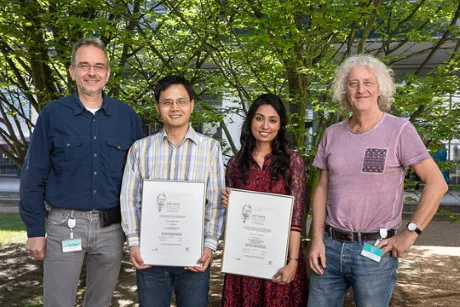This year, it was junior scientists from Pakistan and China who received awards from the Max Planck Institute of Molecular Plant Physiology. The awards were presented on 23 May 2019 at a scientific congress held on the occasion of the 25th anniversary of the Institute. The postdoctoral award went to Dr Guo-Zhang Wu from China, and the doctoral award, to Umarah Mubeen from Pakistan.

Prof. Dr. Ralph Bock, awardee Dr. Guo-Zang Wu, awardee Umarah Mubeen, Prof. Dr. Mark Stitt (from left to right)
Dr Guo-Zang Wu was awarded for identifying an important stress management factor in plants for intracellular communication. In humans and other mammals, the brain, nervous system and blood circulation can be thought of as the control centre, sensors and information pathways of the body. They are the conduit of information and the means by which actions are initiated. Plants are not equipped with such systems. How then do they detect adverse or even life-threatening environmental conditions, and how do they go about activating defence systems and protective mechanisms? Their internal communication channels are diverse. One level of communication is between the nucleus, containing the genes, and the organelles, termed plastids and mitochondria, which also contain genetic information. The plant cell nucleus is the cellular control centre in which the majority of hereditary traits are encoded. The organelles are primarily responsible for cellular energy production through photosynthesis and respiration. They can send signals to the cell nucleus to initiate the formation of proteins which, among other things, enable the construction of the machinery of photosynthesis and the biosynthesis of chlorophyll in the chloroplasts. Such signals were presumed to exist as far back as 30 years ago. Until now, however, they couldn't be detected, or their molecular identity, clarified.
Dr Guo-Zang Wu's special contribution has been to show for the first time how this type of communication between cell nucleus and organelles actually works. He demonstrated the existence of a protein known as GUN1, which plays a central role in the cell nucleus in forming proteins that are then imported into chloroplasts to counteract stress situations. Dr Wu developed a number of new biochemical and cell-biological approaches to identify and detect the GUN1 protein. The difficulty was that this protein is exceptionally unstable, which is why it's only present in very low concentrations in green leaves, as he showed in an earlier paper. His current work involved plants that are unable to produce the GUN1 protein. As a result, these plants can't transport enough proteins into the chloroplasts. To prevent the lack of protein transport from the cell nucleus into the chloroplasts resulting in cell damage, these plants switch on genes for stress proteins. The findings from this work may pave the way to developing improved crops that are better adapted to unfavourable environmental conditions.
The award for doctoral students goes to Umarah Mubeen from Pakistan for research on a protein complex involved in the regulation of growth processes. The protein TOR is found in animals, fungi and plants and is a central regulator of growth and metabolism in all eukaryotic organisms. The acronym TOR stands for “target of rampamycin”. Although TOR's signal transduction is well characterized in various animals and plants, little is known about its regulatory function in the growth of photosynthetic organisms. Umarah Mubeen's research was on the unicellular green alga Chlamydomonas reinhardtii. The alga is one of the most important model organisms scientists study to investigate the processes of developmental biology and physiology in higher plants. Mubeen's goal was to investigate the molecular and physiological effects of inhibiting TOR. Her method was to perform time-resolved analyses over the entire daily cycle, which showed that such inhibition suppresses growth by 50% and delays the cell cycle. Performing metabolic analyses, she was able to show that a rapid redistribution of carbon occurs within a few minutes after TOR inhibition. In addition, levels of nitrogen-rich compounds, in particular, such as amino acids increased. This indicates that TOR is responsible for controlling the cell’s carbon-nitrogen equilibrium, thereby controlling biomass production, growth and the cell cycle.
Mubeen's first thought was that the accumulation of amino acids was due to the degradation of non-essential proteins or to reduced protein synthesis. Her analytical approach, however, allowed Mubeen to prove that this was not the case. She used stable isotopes to track the transport, production and degradation of component molecules after TOR had been inhibited, enabling her to understand the amino acid accumulation. Contrary to previous assumptions, this was the result of increased nitrogen uptake. The conclusion is that the cell is directly forming new amino acids, a surprising result as forming amino acids costs energy.
As TOR is found in various animals and plants, further work on its function in the alga Chlamydomonas will contribute to closing a knowledge gap spanning yeasts, mammals and photosynthetic organisms, and thus to understanding growth regulation in a huge variety of eukaryotes.
